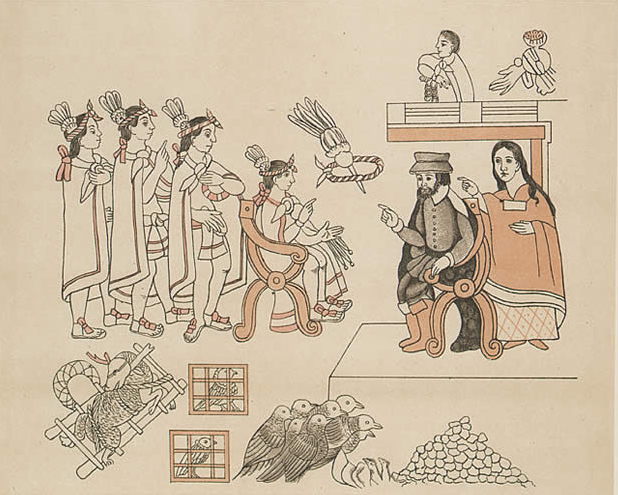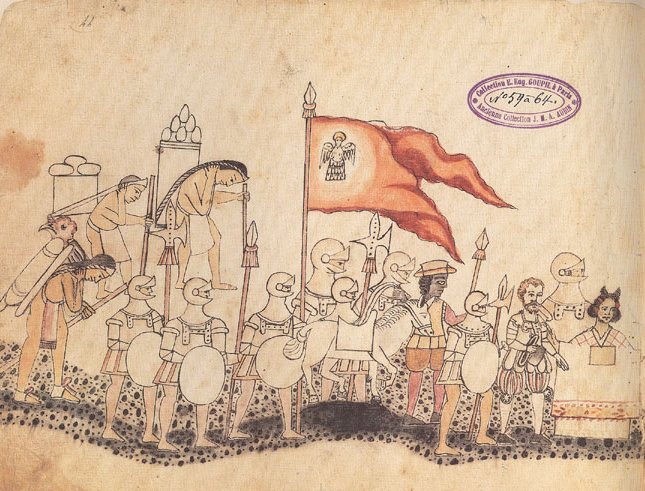Week 4: Conquest and Collaboration
The European exploration and conquest of the Americas caused some of the most devastating cultural encounters in world history, often regarded as the violent outcome of two worlds colliding. Yet what does it mean to speak of "cultures" that encounter or clash with one another? Can we productively break down meta-categories of "European" or "Amerindian" to obtain a clearer sense of the complex entanglements, negotiations, and communication processes that shaped the outcome of cross-cultural interactions? How important were local allies and intermediaries in this story? And how should we interpret the experiences, loyalties, and strategies of men and women caught in the middle? LINK.
Required Readings
Metcalf, Alida C., Go-Betweens and the Colonization of Brazil 1500-1600 (Austin: University of Texas Press, 2005), Ch. 1: 'Go-Betweens', pp. 1-15. Link.
Townsend, Camilla, Malintzin’s Choices: An Indian Woman in the Conquest of Mexico (Albuquerque: The University of New Mexico Press, 2006), 'Introduction', pp. 1-10; and Ch. 7: 'The Concubine Speaks', pp. 148-171. Link.
Primary Source Texts (select one)
Léon-Portilla, Miguel, ed., The Broken Spears: The Aztec Account of the Conquest of Mexico (Boston: Beacon Press, 1962), pp. xi-xxii, 62-81. Link.
Schwartz, Stuart B. (ed.), Victors and Vanquished: Spanish and Nahua Views of the Conquest of Mexico (Boston/New York: Bedford/St. Martins, 2000), Ch. 3: 'Encounters', pp. 79-99.
Seminar Questions
- Discuss Metcalf’s account of go-betweens as “third parties”: what are its merits and limitations?
- Victim? Survivor? Traitor? Heroine? Who was Malintzin and what does she teach us about go-betweens and their predicament?
- How does Hernán Cortés “translate” foreign realities in his Letter to Charles V?
- What forms of intermediation does Bernal Díaz record?
- The Spanish-Amerindian encounter is often told through a narrative of “two worlds collide”: identify elements in The Florentine Codex (Victors and Vanquished; The Broken Spears) that support and challenge such a reading; can you suggest reasons for each?
- How have changing political circumstances shaped the ways modern audiences have read the European-Amerindian encounter?
Further Reading
Andrien, Kenneth J., The Human Condition in Colonial Latin America (London: Eurospan, 2002).
Bayly, C.A., Empire & Information: Intelligence Gathering and Social Communication in India, 1780-1870 (Cambridge: Cambridge University Press, 1996) – Ch. 2: ‘Political intelligence and indigenous informants during the conquest of India, c. 1785-1815’, pp. 56-96.
Cave, Scott, 'Madalena: The Entangled History of One Indigenous Floridian', The Americas 74.2 (2017): 171-200.
Cypess, Sandra Messinger, La Malinche in Mexican Literature: From History to Myth (Austin, TX: University of Texas Press, 1991).
Downs, Kristina, ‘Mirrored Archetypes: The Contrasting Cultural Roles of La Malinche and Pocahontas’, Western Folklore 67.4 (2008), 397-414.
Greenblatt, Stephen, Marvelous Possessions: The Wonder of the New World (Chicago: The University of Chicago Press, 1991), Ch. 5: ‘The Go-Between’, pp. 119-151.
Greenblatt, Stephen, New World Encounters (Berkeley: University of California Press, 1993).
Gruzinski, Serge, Eileen Corrigan (trans.), The Conquest of Mexico: The Incorporation of Indian Societies into the Western World, 16th-18th centuries (Cambridge: Polity Press, 1993).
Gruzinski, Serge, Painting the Conquest: The Mexican Indians and the European Renaissance (Paris: Unesco/Flammarion, 1992).
Jager, Rebecca K., Malinche, Pocahontas, and Sacagawea: Indian Women as Cultural Intermediaries and National Symbols (Norman: University of Oklahoma Press, 2015).
Karttunen, Frances, Between Worlds: Interpreters, Guides, and Survivors (New Brunswick, NJ: Rutgers University Press, 1994) – Ch. 1: ‘To the Valley of Mexico: Doña Marina, “La Malinche” (ca. 1500-1527)’, pp. 1-22.
Meuwese, Mark, Brothers in Arms, Partners in Trade: Dutch-Indigenous Alliances in the Atlantic World, 1595-1674 (Leiden/Boston: Brill, 2012).
Restall, Matthew, Seven Myths of the Spanish Conquest (Oxford: Oxford University Pres, 2003), Ch. 5: 'The Lost Words of La Malinche: The Myth of (Mis)Communication', 77-99.
Rogers, Claudia J., 'Malintzin as a Conquistadora and a Warrior Woman in the Lienzo de Tlaxcala (c. 1552)', Historical Journal 63 (2021), First View.
Schroeder, Susan, Stephanie Wood, and Robert Haskett (eds.), Indian Women of Early Mexico (Norman and London: University of Oklahoma Press, 1997).
Townsend, Camilla, ‘No One Said it was Quetzalcoatl: Listening to the Indians in the Conquest of Mexico’, History Compass 1 (2003): 1-14.
Wachtel, Nathan, Vision of the Vanquished: The Spanish Conquest of Peru Through Indian Eyes, 1530-1570 (Hassock: Harvester Press, 1977).
White, Richard,The Middle Ground. Indians, Empires, and Republics in the Great Lakes Region, 1650-1815 (2nd ed. Cambridge: Cambridge University Press, 2011).


